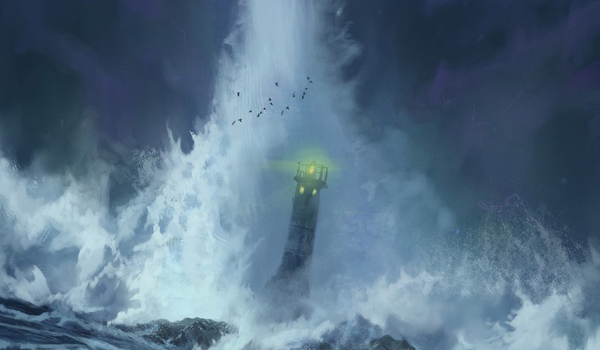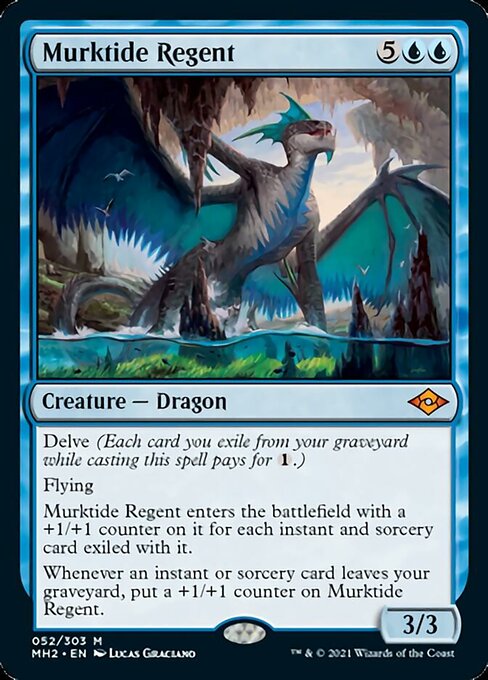Are you a Quiet Speculation member?
If not, now is a perfect time to join up! Our powerful tools, breaking-news analysis, and exclusive Discord channel will make sure you stay up to date and ahead of the curve.
David Ernenwein's recent article on the speed of different proactive decks, "Life in the Fast Lane," touched on a theory topic near and dear to my heart as a thinkin' man: archetypes. I've written extensively on the archetype spectrum wheel, and applied spectrum thinking to topics as trivial as finding a deck I like or as fleeting as figuring out which removal decks were best equipped to beat Champion of the Parish.

Today's agenda seems equally fleeting on paper: we're talking about the best deck in Modern, and those have a habit of changing. But maybe it's actually more evergreen. For one, Wizards has head-scratchingly decreed that UR Murktide ain't going nowhere despite its dominance. And for two, the deck has been dominating (as in, been an outlier in the data) for a record-breaking period of one year. Man, has it been a year already? Yep; the deck first became an outlier last March. (And spoiler alert, it will continue to be an outlier in next week's monthly metagame report.)
So happy one-year-of-dominating-Modern birthday, Murktide Regent! With any luck, this article will remain relevant well into the 2030s as Murktide continues to have its cake and eat it, too.

You may be wondering: besides a burning desire to create the above graphic, what prompted me to crawl out of my editor's cave and submit 3000 words about (presumably) something? To answer that, I'll finish my boring History of Archetype Articles story from before, and then we'll circle back to David. By the end, I'll have made my case for why UR Murktide is not just broken but belongs to a storied lineage of indomitable decks wielding the most powerful strategy in Magic.
What's That Archetype?
My theory work on archetypes led me to write "Death's Shadow of Doubt: Exploring Aggro-Control," which I continue to link today as something of a definitive text on tempo, midrange, and the ever-fuzzy micro-archetypes of rock, fish, stompy, and thresh (from least to most fuzzy). I say "fuzzy" as Magic players are somewhat notorious for disagreeing about the meanings of such terms. What I called thresh decks in my article, David called Delver decks in his. And what he called threshold decks... well, what do I call those?
Threshold: Murktide-style decks
This is the point where it starts getting hard to separate the aggro from the midrange deck. While Modern UR Murktide and the very similar Legacy UR Delver play cheap threats, they're typically throw-away threats. The intention is to disrupt the opponent until it's time to drop a big threat and ride it to victory. That might happen early, and it might happen late. Which is perilously close to midrange's strategy.
Life in the Fast Lane: How to Get the Most Out Of Proactive Decks
When I read David's definition of "Threshold: Murktide-style decks," I realized Modern's UR Murktide deck indeed exists in a class of its own. That's not to say such an archetype is new. For the first time, I recognized in UR Murktide an ancient and powerful archetype thought lost to the ages, or at least to shrewd banlist management. And no, it wasn't midrange.
In my eyes, aggro-control decks are interactive creature decks that disrupt opponents with either spells or permanents. They are also fair, meaning they don't cheat on resources and do win over multiple combat steps. There are two types of aggro-control decks: midrange and tempo. Whether an aggro-control deck falls under one category or the other depends on the order in which it tends to deploy its threats relative to its disruption.
Midrange: Disrupts opponents, then establishes a clock.
Death’s Shadow of Doubt: Exploring Aggro-Control
Tempo: Establishes a clock, then disrupts opponents.
UR Murktide plops down A-Dragon's Rage Channeler or Ragavan, Nimble Pilferer and disrupts opponents until they're dead. Smells like tempo. But I do think the confusion is justified, in the same way it was for Shadow decks when they were fresh on the scene.
For starters, and this was also true of Shadow decks, Murktide has decent reversibility, meaning it can assume the role of its archetypical opposite when necessary; in this case, that means being midrange, or disrupting fast starts from opponents with cards like A-Unholy Heat and Counterspell before getting proactive with its own threats. However, where Shadow plays as a midrange deck by default, Murktide plays as a tempo deck by default. So far, so good.
Another more insidious reason is that David is spot-on about Murktide's true motives, and those don't jive with those of a thresh deck. Thresh must protect its efficient little clocks if it wants to win. I agree that DRC and Ragavan, blue-chip thresh bodies though they may be, are frequently "throw-away threats" here. Unlike thresh, UR Murktide doesn't shed so much as a tear when they do bite the bullet.
Rather, it actually plays into UR's plans for these creatures to be dealt with, as in fact they must be if one is to survive the game's first phase, since their corpses go on to feed Murktide Regent, which promptly ends the game unanswered. And how difficult is it to answer a Regent? Well, here is a patently terrible card that people play multiples of in Modern sideboards.
Okay, UR Murktide is not thresh, exactly. Even though it looks like thresh and often plays like thresh. Because it has Murktide to fall back on. What is it, then? And what's so broken about that?
Nameless Inversion
"Thresh" was a name I came up with for "Delver decks" because I was irked by calling them Delver decks. After all, not all decks running 4 Delver of Secrets // Delver of Secrets actually fit under the strategic umbrella I was referring to (some were too aggressive; others too midrangey), and what if those that did fit stopped playing their namesake one day (as recently happened)?
But it wasn't the first name I used for the archetype. Initially, I called them "grow" decks, after Alan Comer's fabled Miracle Grow deck, with which there is significant overlap in both spell and deck composition. My breakout competitive deck was the so-named Monkey Grow, which recovered from the Treasure Cruise ban by mixing Hooting Mandrills, Disrupting Shoal, and Simic Charm into a classic Delver-Bolt shell.
Give that article a click (it features both decklists) and note the striking structural resemblance between Miracle Grow and Monkey Grow. Despite their apparent similarity, though, the two decks employ different strategies to actually win. And their power levels couldn't be more disparate. Monkey Grow never fully caught on despite my own humble successes with the deck, while the original Miracle Grow defined a format and changed deckbuilding forever. As it so often does, the difference lies in a single card.
I stopped calling Delver decks "grow" and started calling them "thresh" as soon as I came to realize that grow decks are their own separate thing. Delver decks are usually not grow decks. Miracle Grow, however threshy its components on paper, earns the grow label not with its cards but with its strategy, or the way it counts on winning its games. So does Gro-A-Tog, which notably looks nothing like a Delver deck, but generally wins in the same fashion as Miracle Grow.
Delver decks can be grow decks, though. When they are, these decks tend to rule their format and then eat a ban. That's not Delver's fault. It's because at critical mass, grow is a strategy so broken that nothing in Magic has ever been able to keep pace with it.
Veteran readers will notice that "thresh" is a new name I've given to what I used to call grow decks. [...] "Thresh" more accurately reflects an important aspect of these decks: that they'll happily throw away cards in exchange for a tempo advantage, and closely budget their resources (especially mana) throughout the duration of most games.
Conversely, many of Magic's most famous grow decks, including the fabled Miracle Grow and the combo-control slanted Vintage powerhouse Gro-A-Tog, possess built-in ways to recoup card advantage at little cost à la Treasure Cruise (frequently, via Gush), which Thresh decks lack. In hindsight, the only true grow deck Modern has seen was the Cruise-featuring URx Delver.
Death’s Shadow of Doubt: Exploring Aggro-Control
The Meaning of Grow
Thresh, so named for Legacy's Canadian Threshold, eventually runs out of resources; its creatures eventually become outclassed. That's why it's crucial to win within a specific window against most decks (as David put it, turns 5-8). Grow suffers no such limitation. It can play an uncompromising thresh tempo game. And then, when it gets low on resources, it slams Gush and refills on cards. Now it's got a new Quirion Dryad; a new Werebear. And those shiny new creatures seal the deal.
As mentioned in the above quote, we've had one such deck in Modern. Players could take out its early creatures, and indeed needed to or they would lose. But when they did, the deck would slam Treasure Cruise and refill on cards. Then it would have a new Delver of Secrets // Delver of Secrets; a new Young Pyromancer. Of course, opponents wouldn't magically have the new removal spells needed to keep up.
In playtesting with Maxim, I learned to truly appreciate and understand the absurd power level of a deck that could play aggressively when pressed but was perfectly content to take the opponent into the lategame and bury them in card advantage, even against dedicated control decks that thought they should own the lategame. You see, the correct way to play this deck was not as an aggro deck. Instead you used your creatures to occupy your opponent’s attention and resources early in the game while you set up to profit from drawing a lot fewer lands and having free card drawing later in the game.
Carsten Kotter, "Gro History and Current Legacy"
And now, we have UR Murktide. Ragavan and Channeler run you over unless you trade resources to slow its aggressive starts. Your reward for playing along? It slams Murktide Regent. And here's where things differ slightly from our previous examples, since Murktide is not a draw spell. There is no new Ragavan; no new Channeler. It's turn four in 2023; what good is drawing into a 2/1 and a 3/3 anyway? Instead, there's this 8/8 with flying. You can't block it. You can't Push it. You can't Heat it. It will kill you in one or two turns.

Murktide doesn't look exactly like the grow decks we've come to memorialize, reason being that once you zap its weenies and clear Level 1, it's not filling up on free cards. Instead, it's landing a threat that is actually worth those free cards. And you are losing all the same, because Murktide is still grow, and grow is still broken.
Appraising Murktide Regent
That last claim might need some defending. Is Murktide Regent really worth those free cards? How many cards is it worth? Gush offers two for no mana; Cruise offers three for one mana. Regent offers ??? for two mana. I find that when it comes to assessing individual cards, it can pay off to compare them with known quantities.
Consider StifleNought, a decades-old Legacy deck that continues to put up results today. That deck wants to combine Stifle (which is a playable Legacy card in its own right) with Phyrexian Dreadnought (which isn't) to cheat out a 12/12 trample body that closes out the game in short order. It can be built in a tempo shell, with other cheap threats to divert from this purpose, or a midrange one, generating value with engine cards while it assembles its combo.
Casting both halves of the StifleNought combo, like Regent, costs two mana, making it a great point of comparison for assessing the Dragon. I do think that a 12/12 with trample is a bit better than an 8/8 with flying, but taking into account that this is Modern and Regent is immune to both Fatal Push and Prismatic Ending, I'd much rather have the blue guy. So let's call their bodies a wash. Solving for Regent, then, here's what you get for your two mana and a card.
Count 'em: three cards, including a combo payoff good enough to buoy its own Legacy strategy for nearly 20 years (whether that explosive reliability is worth a .5 shall remain up for debate). You get the huge, evasive body on board (Dreadnought + Stifle). That's two. And you get them "entwined" on a single spell, which is also worth one card: instead of drawing the two pieces with your two draw steps, you draw Murktide and another card, here represented by Reach Through Mists.
Thought of this way, Murktide is actively better than StifleNought—no more assembling the combo, and a free card to boot, for the same mana investment. (Fun fact: some StifleNought lists have taken to running Murktide Regent themselves!)
Here's another point of comparison:
Three cards again. You could find two copies of Hooting Mandrills with your one Expressive Iteration. Certainly, you might be quite happy to rip eight trampling power for two mana off the top of the deck. But Murktide triumphs: here's eight flying power for that same two mana, plus an additional pick off the Iteration. And as a bonus, you're delving six cards instead of ten, a graveyard sale close to half off.
So... spend one card, get three cards. Sound familiar?
It's turn five, and our opponent has weathered the initial onslaught of one-drops. By this stage, UR Delver would have drawn its Treasure Cruise and be primed to cast it for one mana, or "basically free." We are likely to have found our massive Dragon. And the way both players have navigated the game all but ensures that it will come down for two mana, or "basically free." A one-card investment that essentially yields the two-card StifleNought combo, netting a card in the process of fielding a game-ending threat.
The grow deck is designed to lead the game to this exact place. Grow accesses its overpowered spell not by ramping with mana dorks and rituals, or by painstakingly finding all the Tron lands, as many lesser decks do; that would cost cards and time. Instead, it gains access doing what the other lesser decks are happy to call their whole gameplan: by putting opponents on a clock with the format's most efficient attackers. And then it takes over the late-game for "basically free." Ain't that just like a birthday? With grow, you have your cake and eat it, too!
Grow? In Your Format? Here's What to Do...
Beating grow is simple enough: you slug through the one-drops and counterspells and advantage generated by Expressive Iteration along the way, and then you have Run Afoul or hopefully a better card like Leyline Binding for the Regent, and at the same time you get your gameplan online and popping before the enemy can pull ahead again with another Murktide or EI. Simple, but a lot of work. And while it's definitely possible, it's not so feasible that UR Murktide can take one month out of a whole year off from being the unequivocal best deck in Modern by the numbers.
When I say grow is broken, I mean that players cannot reliably self-regulate the menace. Just as Merfolk running Relic of Progenitus and Chalice of the Void back in the day was not enough to displace Cruise-powered UR Delver, Elementals packing Run Afoul won't unseat UR Murktide from its throne.
Historically, the only sure-fire way to deal with the best grow deck has been to ban its enabler, or the card that single-handedly allows it to pull far ahead once opponents have successfully traded off in the early game. Otherwise, the second-best grow deck will rise to claim the title of format boogeyman.
This is a principle Wizards seems to understand. That's why they banned Gush in Pauper, and restricted it (what seems like permanently this time) in Vintage. And Treasure Cruise (pretty much everywhere). And just this month, Expressive Iteration in Legacy (two mana for what I see as 2.5 cards, given the sorcery's selection aspect).
Our choice is to ban Expressive Iteration, as the card quality and quantity it provides allows Izzet Delver to easily adapt to stay on top of any changes in the metagame.
In addition to removing a generally strong card, our hope is that by removing Expressive Iteration, we reinforce Izzet Delver's historical strengths (efficient one-for-one exchanges) and weaknesses (lack of sources of card quantity) in a way that leaves the deck more vulnerable in the metagame.
MARCH 6, 2023 BANNED AND RESTRICTED ANNOUNCEMENT
While official banlist announcements don't come out and say "grow is broken and this card enables a grow deck," the pattern is pronounced and consistent. I think Wizards probably sees it more along the lines of "tempo decks become broken when they have easy access to a stream of cards," which doesn't account for the whole tempo vs. grow gameplan nuance we laid out earlier, but does hit at the heart of how grow's superiority as an archetype routinely manifests itself in competitive settings.
Grow being broken explains why UR Murktide has enjoyed statistical outlier status in Modern for a record-breaking one-year period. The deck has dominated not via the endless strings of Top 8s we saw with Cruise-fueled Delver, but through an unshakeable throttle of the data. That makes it all the more suspicious that Wizards apparently doesn't see any issues with Modern.
They Must Take Us for Werebears
As with the last update, Modern continues to be in a healthy spot, with plenty of different viable archetypes and a relatively flat spread among the top decks' metagame shares. Izzet Murktide is currently the most popular archetype in competitive play, but not by a large margin, and the deck isn't showing a concerning win rate.
MARCH 6, 2023 BANNED AND RESTRICTED ANNOUNCEMENT
It could be that since UR Murktide is deploying Murktide Regent and not a literal card-drawer like Cruise in its grow-qualifying "Gush phase," Wizards just hasn't yet recognized it as being a grow deck. Big bodies haven't been a problem in the past, whereas free cards have, although as explored in the previous section, the situation unfolds differently when the big body in question is a pair of airborne Hooting Mandrills. Murktide Regent sits somewhere between Gurmag Angler and Emrakul, the Aeons Torn.
Regardless, failing to fully grasp the strategic weight of Murktide the card is a lousy excuse for letting Murktide the deck off the hook after a year of sitting on Modern's face. And make no mistake, that is what Wizards has done with their latest announcement. So what is really going on?
My guess is that Murktide Regent is not just a card, but actually a real entity, a monster that was once a Magic player, the spirit of Alan Comer warped and distorted from years of casting powerful, forbidden draw spells. From deep in the shadows, like that giant baby in the Star Wars sequels, he runs the banlist meetings at Wizards HQ, ensuring that his cardboard likeness, the invitational card he never earned and thus was forced to scheme for, indefinitely maintains its stranglehold on the format. But I'm open to hearing your theories in the comments.

















